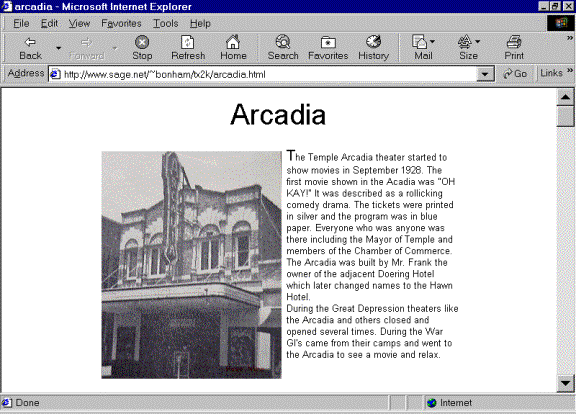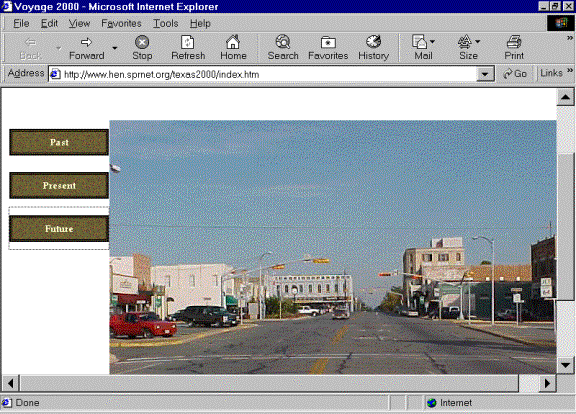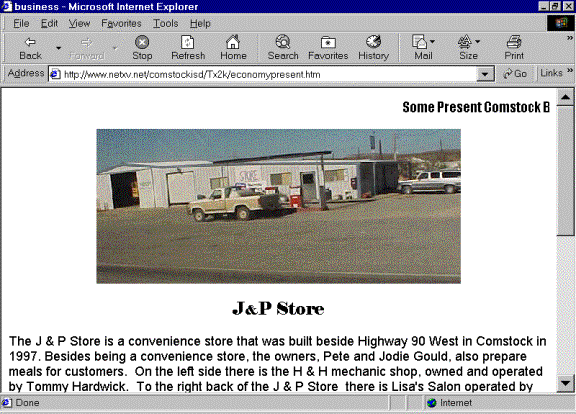
by John Slatin
The University of Texas at Austin
Currents
in Electronic Literacy Spring 2000(3),
<http://www.cwrl.utexas.edu/currents/spr00/slatin.html>
- The project described here represents one of many preliminary steps toward such a distributed model. TX2K is an Internet-based, interdisciplinary project which embodies the constructivist principle that learning takes place through focused social interaction about topics that participants find personally engaging. TX2K’s activities are designed to help students create a bridge between their evolving interest in their own emerging identities as members of their local communities on the one hand, and the seemingly abstract requirements of the curriculum on the other -- that students develop research skills, learn how to acquire information from a number of different sources and present it in a variety of formats, write differently for different purposes and different audiences, learn social studies, mathematics, science, and so on. As curators of the living museum, students throughout Texas research and prepare three online exhibits about their communities’ past, present, and future. Carefully structured research activities combine local materials with online resources from the University’s library and museum holdings as well as other Internet resources. Each exhibit addresses five broad research categories: Economy, Environment and Geography, Government, Infrastructure, and People and Culture. Once exhibits have been completed and published via the TX2K Web site, virtual field trips and online dialogues link participants with peers in other communities. Summer workshops prepare teachers for successful participation, launching collaborative relationships to be sustained throughout the school year by email and other electronic means.
- TX2K is designed for middle schools and high schools. Beginning in 2000-2001, elementary schools will participate on a limited basis. In 1999-2000, participants included approximately 1100 students and 185 teachers from 58 schools in 37 separate districts; 24% of participating schools are classified as geographically isolated, and more than 50% of participating students are economically disadvantaged.
- The major components of the TX2K Web site are as follows: the Curator’s Workshop, where participants find the tools they need to create and manage their exhibits; the Gallery, where completed exhibits are on display; and the Message Boards, where online dialogue takes place. The TX2K Library provides links to a wide variety of Internet resources. The Museum Office affords a comprehensive set of administrative tools as well as message-boards reserved for teachers and a database of ideas for exhibits; teachers are encouraged to contribute activities to the database and to share other resources such as worksheets, templates, evaluation rubrics, and the like via the Web site. The Information Desk provides online help; the TX2K Lobby is a jumping-off point from which museum visitors can begin their investigations.
- A TX2K exhibit is a multimedia record that documents some aspect of a community’s life—a specific incident, a period in its history, a place, and so on. Each exhibit consists of at least five “digital artifacts,” one for each of the five research categories (Economy, Environment and Geography, Government, Infrastructure, People and Culture). Photographs have been the most common artifacts so far, but TX2K can accommodate sound files, video and animation sequences, and even other Web pages. Each digital artifact is accompanied by descriptive and explanatory text. Exhibits are framed by “Day in the Life Narratives” that represent life in the community from the first-person perspective of a real or fictional member of the community, and by “Dialogue Starter Questions” that prompt online discussion.
- Like several other TX2K activities, this one originated in a colleague's suggestion. Professor Rosa Eberly of the University of Texas's Division of Rhetoric and Composition, an expert on rhetoric and the public sphere, contributed her suggestion in response to a request I sent via email to some several dozen faculty members at UT Austin. In the email I explained the TX2K project and invited respondents to send me a "research question"—that is, a question to which they did not know the answer and which K-12 students could meaningfully (and safely!) pursue. The idea for this broadcast appeal for research questions was inspired most immediately by a conversation with Dr. Douglas Barnett, Managing Editor of the New Handbook of Texas, exploring ways in which students might provide meaningful local details to which authors of the 23,000 articles in the Handbook could not possibly have had access. It may also have been informed by the work of one of Ph.D. student Madelyn Starbuck, an artist who gathered material for the first "cyberspace opera" (honoria in ciberspazio) by issuing a call over the Internet for interested persons to send her rhyming couplets, which she then transformed into a remarkably coherent libretto (see http://www.cyberopera.org).
- TX2K activities situate student research within a deliberately sketchy scenario—in this case a small civic drama. This is in keeping with the constructivist principles to which I alluded earlier, and with the hallmarks of what Etienne Wenger (1998) calls a “community of practice”: (1) mutual engagement in (2) a joint enterprise in which participants develop and employ (3) a shared repertoire of activities, skills, artifacts, ideas, etc. The community of practice is a learning community: indeed, Wenger defines a “practice” as a “shared history of learning” (p. 93). In TX2K, then, creating an exhibit can become a joint enterprise in which students, working in groups, are mutually engaged in developing the shared repertoire of knowledge, ideas, techniques, artifacts, and tools they will need in order to construct their exhibit.
- Students at Bonham Middle School in Temple, Texas—some 60 miles north of Austin—produced an exhibit about their community’s early years, from 1881 (when the town was laid out by engineers from three railroad companies) to approximately 1930. Their exhibit begins at the Arcadia Theater, Temple’s first motion picture theater, and then moves on to the municipal building, the hospital, and a number of other structures representing the period. All of these items are presented on a single page.
TX2K: The Texas 2000 Living Museum
Target Audience
Overview of the TX2K Site
TX2K Exhibits
A Monumental Decision
Past UnitSummary: Students will design an exhibit that examines the most important structure in their community. The Historical Commission has reported that many of the city's monuments and public spaces have been neglected and are now badly in need of repair and restoration. The City Council has agreed, but funds are severely limited. There is only enough money to pay for the repair of one monument. The Council members can't decide which monument to repair and it's your job to help them choose one.
Create an exhibit about the most important monument, building, or public space that was established in your community before 1980. You'll need to persuade people who view your exhibit that this really is [the] best thing to spend the money on. Your exhibit should include artifacts and information about the People and Culture, Government, Infrastructure, Environment and Geography, and Economy.
Places to Begin:
Take a walk: Take a walk around your community and write down ideas for the focus of your exhibit.
Historical Commission: The Historical Commission should have information about the histories of the important places in your community. This will help you decide what is important and why.
Town Library: Once you have picked a monument, building or public space to focus on go to the library. You can research the background of the subject(s) of the site you have chosen.

Exhibit by students at Bonham Middle School in Temple, Texas.
In Henderson—a town of about 10,000 people in northeast Texas—gifted and talented fifth-graders worked with high school seniors to create a structure to house all three of their exhibits. They linked individual exhibits to the page shown below. The exhibit about Henderson’s past consists of multiple Web pages.

The home page for Henderson 2000: TX2K Exhibit created by 5th and 12th-grade
students in Henderson Independent School District in northeast Texas
The Comstock School is the only school in Comstock ISD, in Val Verde County, about three hours west of San Angelo, Texas. There are 147 students in the entire school, which includes grades K-12. The district serves an area of some 2,000 square miles. A high school Web-authoring class produced an exhibit about Val Verde County in the present:

The “Economy” page of Comstock School’s exhibit about Val Verde County
in the present day. This exhibit also includes streaming audio.
Next: Lessons So Far
